Amusement arcade
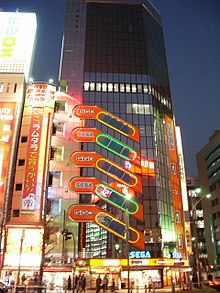
Anamusement arcade,also known as avideo arcade,amusements,arcade,orpenny arcade(an older term), is a venue where people playarcade games,includingarcade video games,pinballmachines,electro-mechanical games,redemption games,merchandisers(such asclaw cranes), or coin-operatedbilliardsorair hockeytables. In some countries, some types of arcades are also legally permitted to providegamblingmachines such asslot machinesorpachinkomachines.Games are usually housed in cabinets.[1][2]
Video games were introduced in amusement arcades in the late 1970s and were most popular during thegolden age of arcade video games,the early 1980s.
History[edit]
Penny arcade[edit]
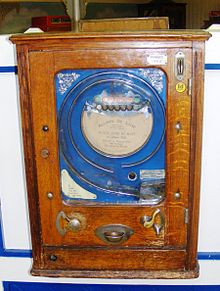
A penny arcade can be any type of venue forcoin-operateddevices, usually for entertainment. The term came into use about 1905–1910.[1]The name derives from thepenny,once a staple coin for the machines. The machines used included:[3]
- bagatelles,a game with elements ofbilliardsand non-electrical pinball,
- early forms of non-electricalpinballmachines,
- fortune-telling machinery,
- slot machines,
- coin-operatedAmberolas
- peep show machines (in the original, non-pornographic, usage of the term), which allowed the viewer to see various objects and pictures
- Mutoscopes
- love tester machines.
- coin-operatedshooter gamesandgun games
Between the 1940s and 1960s, mechanicalarcade gamesevolved intoelectro-mechanical games(EM games). Popular examples of EM games in the 1960s included shooters such asSega'sPeriscope(1965) andRifleman(1967), andracing gamessuch as Kasco'sIndy 500(1968) andChicago Coin'sSpeedway(1969). Penny arcades later led to the creation of video arcades in the 1970s.
1970s and 1980s[edit]
Video game arcades began to gain momentum in the late 1970s with games such asSpace Invaders(1978) andGalaxian(1979)[4]and became widespread in1980withPac-Man,Centipedeand others. Thecentral processing unitin these games allowed for more complexity than earlierdiscrete-circuitrygames such as Atari'sPong(1972).
During the late 1970s video-arcade game technology had become sophisticated enough to offer good-quality graphics and sounds, but it remained fairly basic (realistic images andfull motion videowere not yet available, and only a few games used spoken voice) and so the success of a game had to rely on simple and fun gameplay. This emphasis on the gameplay explains why many of these games continue to be enjoyed today, despite the progress made by modern computing technology.
Thegolden age of arcade video gamesin the 1980s became a peak era ofvideo arcade gamepopularity, innovation, and earnings. Color arcade games became more prevalent and video arcades themselves started appearing outside their traditional bowling-alley and bar locales. Designers experimented with a wide variety ofgame genres,while developers still had to work within strict limits of available processor-power and memory. The era saw the rapid spread of video arcades acrossNorth America,Western EuropeandJapan.The number of video-game arcades in North America, for example, more than doubled between 1980 and 1982,[5]reaching a peak of 13,000 video game arcades across the region (compared to 4,000 today[when?]).[6]Beginning withSpace Invaders,video arcade games also started to appear insupermarkets,restaurants,liquor stores,filling stationsand many other retail establishments looking for extra income.[7]This boom came to an end in the mid-1980s, in what has been referred to as "the great coin-op video crash of 1983".[8]
On November 30, 1982, Jerry Parker, the Mayor ofOttumwa, Iowa,declared his city the "Video Game Capital of the World". This initiative resulted in many firsts in video game history. Playing a central role in arcade history, Ottumwa saw the birth of theTwin GalaxiesIntergalactic Scoreboard and theU.S. National Video Game Team,two organizations that still exist today. Other firsts that happened in the Video Game Capital of the World included:
- the first video-game-themed parade (Jan. 8, 1983)[9]
- the first video game world championship (Jan. 8–9, 1983)[10]
- the first study of the brain waves of video-game champions (July 12, 1983)[11]
- the first billion-point video-game performance (Jan. 16, 1984)[12]
- the first official day to honor a video-game player (Jan. 28, 1984)[13]
High game-turnover in Japanese arcades required quick game-design, leading to the adoption of standardized systems likeJAMMA,Neo-GeoandCPS-2.These systems essentially provided arcade-only consoles where the video game ROM could be swapped easily to replace a game. This allowed easier development and replacement of games, but it also discouraged the hardware innovation necessary to stay ahead of the technology curve.
Most US arcades didn't see the intended benefit of this practice since many games weren't exported to the US, and if they were, distributors generally refused to release them as simply a ROM, preferring to sell the entire ROM, console, and sometimes the cabinet as a package. In fact, several arcade systems such as Sega'sNAOMIboard are arcade versions of home systems.
Other problems were that many arcades focused on quantity more than quality, and that games showed a rising difficulty curve, making them increasingly inaccessible to casual players and more expensive for the skilled players.[14]
1990s[edit]
The rise of the fighting game genre with games such asStreet Fighter IIandMortal Kombat,combined with the release of popular sports titles such asNBA JamandNFL Blitz,led to a brief resurgence in the popularity of video arcades, with new locations opening in shopping malls and strip malls throughout the country in the early 90s.
The arcade industry entered a major slump in mid-1994.[8]Arcade attendance and per-visit spending, though not as poor as during the1983 crash,declined to the point where several of the largest arcade chains either were put up for sale or declared bankruptcy, while many large arcade machine manufacturers likewise moved to get out of the business.[8]In the second quarter of 1996, video game factories reported 90,000 arcade cabinets sold, as compared to 150,000 cabinets sold in 1990.[15]
The main reason for the slump was increasing competition from console ports. During the 1980s it typically took several years for an arcade game to be released on a home console, and the port usually differed greatly from the arcade version; during the mid-1990s it became common for a game publisher to release a highly accurate port of an arcade game that had yet to peak in popularity, thus severely cutting into arcade owners' profits.[15]
2000s and beyond[edit]
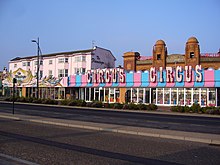
In the late 1990s, a bar opened in the newCrown Casinocomplex inMelbourne,AustralianamedBarcode.Barcode was a 'games bar' with the latest arcade games, the classics, pool tables, air hockey and pinball machines which players could play while consuming alcohol.[16]The bar was very popular with other bars later opening in the early 2000s inKing Streetalongside thestrip clubsand at the shopping centreMelbourne Central.A Barcode opened inTimes Square,New Yorkin May 2000 and was very popular, with the launch featuring on an episode of TV seriesSex and the City.Barcode Times Square closed in March 2003. Barcode Crown Casino closed in 2006, followed later by King Street and Melbourne Central.[17][18]
In the mid-2000s,Madridbusinessman Enrique Martínez updated the video arcade for the new generation by creating a "hybrid movie theater with...fog, black light, flashing green lasers, high-definition digital projectors, vibrating seats, game pads and dozens of 17-inch screens attached to individual chairs." At the Yelmo Cineplex in Spain, $390,000 was spent refitting a theater into a "high-tech video gaming hall seating about 50 people." In Germany, theCinemaxXmovie theater company was in 2007 also considering this approach. It conducted a four-month trial with video games to test the level of demand for video gaming in a theater setting.[19]
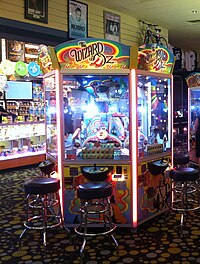

Manufacturers started adding innovative features to games in the 2000s.Konamiused motion and position sensing of the player inPolice 911in 2000 andMocap Bo xingin 2001.[20][21]Segastarted using "Tuning cards" in games such as theInitial Dseries of games allowing the customer to save game data on a card vended from the game;Namcocopied the idea with theMaximum Tuneseries. Arcade games continued to use a variety of games with enhanced features to attract clients, such as motorized seating areas, interconnected games, and surround sound systems. Redemption and merchandiser games are also a staple of arcades in the 2000s. One of the most popular redemption games,Deal or No Dealby ICE, simulates the populartelevision game show.Merchandiser games such asStackerby LAI Games gives the player the chance to win high end prizes like iPods and video game consoles.
At the same time as these innovations, a small resurgence in the interest of classic video games and arcades grew with the opening ofBarcadein Brooklyn, New York in 2004. Barcade combined a video arcade and a full bar, with a strict focus on classic machines from the 1970s and 1980s, known as thegolden age of arcade video games.[22]The idea proved popular and Barcade received recognition as a good place to play classic video game cabinets, because it is "one of the few places where classic arcade games can still be found in public, and in good working order."[23][24]Barcade's success influenced other similarly themed businesses which opened across the country.[25][26]Other arcades, likeGround Kontrolin Portland, Oregon, began including full bars in their arcades.[27]Even regular bars added classic arcade games to their venues.[28]
As the trend grew, the industry and press looked for ways to classify these arcade bar hybrids, with the DNA Association branding them "social-tainment" and also referring to them as "game bars".[29]Many of these newer game bars proved to be popular and expansion continued.[30]
In the UK, classic arcades such as Casino and Trocadero, both located in London, closed, with some of the games from Trocadero finding their way to a new arcade, Heart of Gaming in North Acton.[31]The newer Loading Soho Gaming Cafe features arcade machines manufactured byBespoke Arcadesfor its customers to use.[32]The UK is also home to the largest arcade in Europe, Arcade Club, located in Bury, Greater Manchester. Home to over 400 original arcade machines, it is recognised as the largest collection in Europe.[33]In May 2019 Arcade Club opened a second venue in Leeds[34]with a third announced for Blackpool opening in 2020.[35]
Types of games[edit]
Video games[edit]
Thevideo gamesare typically inarcade cabinets.The most common kind areuprights,tall boxes with a monitor and controls in front. Customers insertcoinsortokensinto the machines (or, in newer models, use credit cards or mobile devices[36]) and stand in front of them to play thegame.These traditionally were the most popular arcade format, although presently American arcades make much more money from deluxe driving games and ticket redemption games. However, Japanese arcades, while also heavily featuring deluxe games, continue to do well with traditionalJAMMAarcade video games.
Some machines, such asMs. Pac-ManandJoust,are occasionally in smaller boxes with a flat, clearglassoracrylic glasstop; the player sits at the machine playing it, looking down. This style ofarcade gameis known as acocktail-style arcade game tableortabletop arcade machine,since they were first popularized inbarsand pubs. For two player games on this type of machine, the players sit on opposite sides with the screen flipped upside down for each player. A few cocktail-style games had players sitting next to rather than across from one another. BothJoustandGun Fighthad these type of tables.
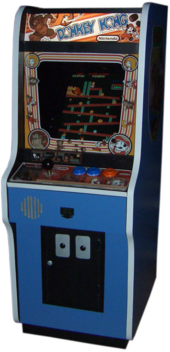
Some arcade games, such asracing games,are designed to be sat in or on. These types of games are sometimes referred to assit-downgames.SegaandNamcoare two of the largest manufacturers of these types of arcade games.

Other games[edit]

Other games includepinballmachines,redemption gamesandmerchandisergames. Pinball machines have a tilted, glass-covered play area in which the player uses mechanical flippers to direct a heavy metal ball towards lighted targets. Redemption games reward winners with tickets that can be redeemed for prizes such as toys or novelty items. The prizes are usually displayed behind a counter or in a glass showcase, and an arcade employee gives the items to players after counting their tickets. Merchandiser games reward winners with prizes such as stuffed toys, CDs, DVDs, or candy which are dispensed directly from the machine.
In some countries, some types of video arcades are legally allowed to providegamblingmachines such asslot machinesandpachinko machines.Large arcades may also have small coin-operated ride-on toys for small children. Some businesses, such asDave & Buster's,combine a bar and restaurant with a video arcade. TheROUND1entertainment chain combines a large arcade with a full-service bowling alley, along with billiards andkaraoke.
Arcades typically have change machines to dispense tokens or quarters when bills are inserted, although larger chain arcades, such as Dave and Busters and Chuck E. Cheese are deviating towards a refillable card system.[37]Retro Arcades are going towards a pay by admission system with the games themselves set to free play. Arcades may also havevending machineswhich sell soft drinks, candy, and chips. Arcades may play recorded music or a radio station over apublic address system.Video arcades typically have subdued lighting to inhibit glare on the screen and enhance the viewing of the games'video displays,as well as of any decorative lighting on the cabinets.
See also[edit]
- List of arcade games
- Musée Mécanique
- Pinball
- Sega World
- Timeline of video arcade game history
- Video game arcade cabinet
References[edit]
- ^abNasaw, David (15 April 1999).Going out: the rise and fall of public amusements.Harvard University Press. p. 154.ISBN9780674356221.Archivedfrom the original on 2014-07-04.Retrieved2013-05-30.
First use of the term [...] between 1905 and 1910
- ^"Penny arcade definition and meaning".Collins English Dictionary.17 February 2023.Retrieved17 February2023.
- ^"Penny Arcade Machines".Archivedfrom the original on 5 August 2016.Retrieved26 June2016.
- ^Wolf, Mark (2007).The Video Game Explosion: A History from PONG to PlayStation and Beyond.Greenwood.ISBN978-0313338687.
- ^Mark J. P. Wolf (2008).The Video Game Explosion: A History from PONG to PlayStation and Beyond.ABC-CLIO.p. 105.ISBN978-0-313-33868-7.Archivedfrom the original on 2021-09-07.Retrieved2011-04-19.
- ^Mark Stephen Price (Atari Games Corporation) (1998)."Coin-Op: The Life (Arcade Videogames)"(PDF).Digital illusion: entertaining the future with high technology.ACM Press.p.444.ISBN0-201-84780-9.Archived(PDF)from the original on 2022-10-09.Retrieved2014-10-02.
- ^Edge Staff (2007-08-13)."The 30 Defining Moments in Gaming".Edge.Future plc.Archived fromthe originalon 2011-10-29.Retrieved2008-09-18.
- ^abcWebb, Marcus (February 1996). "Arcadia".Next Generation.No. 14.Imagine Media.p. 29.
- ^"Welcome to Twin Galaxies".15 February 2009. Archived fromthe originalon February 15, 2009.Retrieved26 June2016.
- ^"Welcome to Twin Galaxies".21 February 2009. Archived fromthe originalon February 21, 2009.Retrieved26 June2016.
- ^"Welcome to Twin Galaxies".21 February 2009. Archived fromthe originalon February 21, 2009.Retrieved26 June2016.
- ^"Welcome to Twin Galaxies".15 February 2009. Archived fromthe originalon February 15, 2009.Retrieved26 June2016.
- ^Tim McVey Day Poster, January 28, 1984
- ^How Arcades Have Evolved To Survive - SUPERJUMP
- ^abWebb, Marcus (September 1996). "Arcade Games Down 40% in Five Years".Next Generation.No. 21.Imagine Media.p. 22.
- ^"Barcode".Barcode bar.Archived from the original on 2007-11-03.
{{cite web}}:CS1 maint: bot: original URL status unknown (link) - ^"Remembering Barcode: NYCs Failed Arcade Club".Destructoid.Archivedfrom the original on 16 August 2016.Retrieved8 July2016.
- ^Porter, Ian (17 August 2006)."Barcode goes Indian as night-life dims at Crown".The Age.17 August 2006.Archivedfrom the original on 13 February 2016.Retrieved8 July2016.
- ^Carvajal, Doreen (2007-02-26)."The New Video Arcade in Spain Might Be the Movie Theater".The New York Times.Archivedfrom the original on 2014-10-06.Retrieved2014-10-02.
- ^"Police 911 Videogame by Konami (2000) – The International Arcade Museum and the KLOV".Arcade-museum.Archivedfrom the original on 2010-11-15.Retrieved2011-07-21.
- ^"MoCap Bo xing Videogame by Konami (2001) – The International Arcade Museum and the KLOV".Arcade-museum.Archivedfrom the original on 2010-02-10.Retrieved2011-07-21.
- ^Weiss, Jennifer (2011-04-22)."For Arcades, Survival now Hinges on Alcohol".Wall Street Journal.Archivedfrom the original on 2014-10-06.Retrieved2014-10-02.
- ^June, Laura (2013-01-16)."For Amusement Only: The Life and Death of the American Arcade".theverge.Archivedfrom the original on 2014-10-06.Retrieved2014-10-02.
- ^Allen, Ted."Best Bars: Barcade".Esquire.Archived fromthe originalon 2014-11-13.Retrieved2014-10-02.
- ^Wenzel, John (2011-05-01)."From LoDo to the Smithsonian, Video Games Get Their Due".The Denver Post.Archived fromthe originalon 2012-11-14.Retrieved2014-10-02.
- ^Lande, Samantha (2012-02-14)."Emporium Arcade Bar Opening in March".Chicago Eater.Archivedfrom the original on 2013-04-10.Retrieved2014-10-02.
- ^Hottle, Molly (2011-02-15)."Ground Kontrol Arcade to Reopen Thursday with Party".oregonlive. Archived fromthe originalon 2013-11-10.Retrieved2014-10-02.
- ^Petkovic, John (2013-04-25)."B Side Liquor Lounge in Cleveland Heights Adds Old-time Arcade Games".cleveland.Archivedfrom the original on 2014-10-06.Retrieved2014-10-02.
- ^K Williams (2013-05-20)."A Nascent Trend, the Rise of the Gamebar".dna-association. Archived fromthe originalon 2016-03-28.Retrieved2014-10-02.
- ^Ocean, Justin (2014-07-14)."Boozy Sleepovers and Booby Bounce Houses: Kids' Activities for Grownups".Yahoo! Travel.Archivedfrom the original on 2014-10-06.Retrieved2014-10-02.
- ^Parkin, Simon (2014-08-17)."The Last Arcade".Eurogamer.net.Archivedfrom the original on 2014-10-06.Retrieved2014-10-02.
- ^Arcade Hero Staff (2013-05-03)."LOADING SOHO Gaming Cafe Added To The MADD Bar In London".Arcade Heroes.Archivedfrom the original on 2014-10-06.Retrieved2014-10-02.
- ^"We found the Biggest Arcade in Europe inside a Warehouse in the middle of Bury".Manchester’s Finest.2019-05-26.Archivedfrom the original on 2020-06-11.Retrieved2020-06-11.
- ^"Arcade Club Leeds – Everything you need to know".yorkshireeveningpost.co.uk.13 July 2019.Archivedfrom the original on 2020-06-11.Retrieved2020-06-11.
- ^"Arcade Club: Classic arcade with 250 games teased to open in Blackpool – here's everything we know so far".blackpoolgazette.co.uk.4 December 2019.Archivedfrom the original on 2020-06-11.Retrieved2020-06-11.
- ^"Mobile, credit and debit card payments for amusement and arcade machines".Archivedfrom the original on 2020-02-26.Retrieved2019-11-20.
- ^"CEC Token Cards – Token Museum".showbizpizza.Archivedfrom the original on 2011-07-05.Retrieved2011-05-04.
Bibliography
- Namerow, Wayne.The Pennyarcade Website.Retrieved 2004-02-06.
External links[edit]
- History of video gamesatCurlie
- Gameroom Show,Penny arcade related website
- PennyMachines.co.uk,British penny slot and amusement machine website
- Illustrations of various machines
- ArcadeTreasuresArchived2011-07-07 at theWayback Machine,Various penny arcade games with many pictures
- Aurcade,Arcade Games by location
- Classic Arcade Games Locations,Wiki list of classic arcade games by location
- The International Arcade Museum,Home of theKiller List of Videogames,International Arcade Museum Libraryand theVideogame and Arcade Preservation Society
